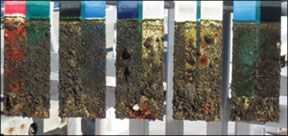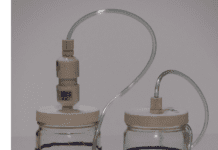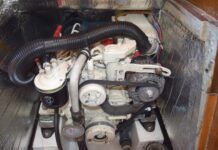I thought the letter in the November 2010 Mailport about how black antifouling paint worked better than other colors was interesting. I have not seen that any color works better than any other color. Many people think that black antifoulings do not work as well because they absorb more heat and make a “more hospitable” place for fouling to grow.

Photos courtesy of Jim Seidel
288
I have attached some photos (at right) of a recent panel inspection of experimental antifoulings at our International Paint test site in Palm Beach, Fla. They are different colors of the same paint that have been in testing for the same length of time. The panels pictured are of antifouling that is sold in Europe with a biocide not registered here in the U.S.
Jim Seidel
Assistant Marketing Manager,
Interlux Yacht Finishes,
www.yachtpaint.com
We appreciate Interlux’s sharing these photos and findings with our readers. As we mentioned previously, our own tests have not been able to establish that color is of any great significance, except in the case of photosensitive paints like Epaint.
I appreciated your note about the Sailor’s Solutions (www.sailorssolutions.com) wireless remote switch in the November 2010 Chandlery. I have one wired to turn my deck light on/off by wiring it in parallel to the usual switch.
I paid less than half your quoted price ($50), buying it from an electronics parts supply house (www.
allelectronics.com). The 12-volt, 15-amp keychain remote control kit came with a receiver and two key fob transmitters for $22, but it did not come with an inline fuse as the Sailor’s Solutions one does.
Karl Mielenhausen
Silver Lining, Catalina 320
New Bern, N.C.
Recently re-reading the April 2010 issue, I noted your story on bird deterrents was largely unproductive at finding one that really worked for all applications. I believe I have stumbled on a simple solution that keeps most birds away. I ran an old DVD up the flag halyard, and apparently, the light flashing off the flip-flopping reflective DVD scares most of them away. I have a couple of pesky osprey that liked the top of my mast who seem to be around less these days. For the cost, it’s worth a try.

Photos courtesy of Jim Seidel
288
Al Alexander
Sasha, 390 Beneteau
Punta Gorda, Fla.
Mission ‘CNG Re-fill’ Update
I have been on a frustrating search for someone in Florida to fill my CNG tank, and I finally found him in Fort Lauderdale, Fla. If anyone else is interested, contact Scott Nobles at 954/636-4291.
Henry Bernstein
Via e-mail
Scott, a certified CNG mechanic (ASE F1), told PS that he can handle CNG jobs in Florida, pretty much from Orlando, Fla. south. The above phone number is the office number for Wise Gas Inc., www.wisegasinc.com.
I was surprised to see the letter submitted by Ed Mini in your November 2010 edition of Practical Sailor. The way this article comes across is you can almost build The Wirie for $87.50, but the article is not entirely accurate.
Although Mr. Mini says his setup is almost identical to The Wirie, “but costs $87.50 instead of $250,” there are only two components that are the same/similar between his project and our product. The only two components that might be the same (as I don’t know the actual parts he is representing) are the AWUS036H WiFi Adapter and the 6-inch coax pigtail. Out of the 10 components we use to build our product, a 20-percent replication is not “almost identical” and a misrepresentation, in my opinion. We have spent countless hours making sure and working with manufacturers to provide only top-end marine-grade components that go into our system. This is a major differentiator from The Wirie and other commercial (and home-built) products on the market that has been minimized and misrepresented by this statement.
He mentions that his version has “a one-year warranty on the only component likely to fail (the Alfa WiFi adapter).” The antenna he uses, as far as I can tell, is not a marine-grade antenna and may fail as well. Our entire product is warranteed for one year. Cables fail, connectors fail, other pieces to his project may fail, and would not be covered under warranty. The Alfa WiFi adapter will not be replaced even within the year as the manufacturer makes no representation for this to be an outdoor device, so in essence, there is no guaranteed warranty on any of the components in his DIY product.
Regarding the antenna, he may be using the same antenna we originally used, and it is in fact rated at 8.5 dBi (not 6 dBi as his letter mentions). However, we have not used that antenna since February 2010 because that antenna does not hold up in the marine environment as well as we require for our product. Once we discovered this, we stopped selling the antenna and partnered with L-Com to manufacture a true marine-grade antenna exclusively for use with The Wirie. The quality of the antenna [in Mr. Mini’s homemade version] compared to what we use, is night and day. The performance with our new antenna is also improved over the antenna we originally used.
We certainly have no issue with people building DIY marine WiFi systems, but want to be clear that the level of product we are manufacturing with The Wirie is not a DIY product as portions of this article are implying. I think it is unfortunate that people are now being misinformed about our product.
Mark Kilty
Island Consulting Inc.
We regret any statements that may be interpreted as a misrepresentation of The Wirie. That certainly was not the intention, as The Wirie is one of the products that stood out as Recommended in the January 2009 test of WiFi antennas. The next time PS addresses WiFi devices, we’ll be sure to include Ed Mini’s DIY version in the field to confirm the performance differences. We also regret letting slip several references to the DIY equipment being rated in “megawatts,” instead of “milliwatts.” Several readers duly chastised us for this mega mix-up. For those who want to try the DIY project, the source for the components used in Mini’s homemade antenna—including the Alpha AWUS036H USB WiFi adapter, the coaxial pigtail, and the 8.5-dBi omnidirectional antenna—is www.data-alliance.net. A “marine” version of 8.5-dBi antenna he used goes for $22. We have not tested any of these components except the Alpha USB WiFi adapter. The company also sells the Ubiquiti Bullet2 wireless access point ($40) used in the two other WiFi systems we reviewed in the January 2009 article on marine WiFi systems. The Wirie is available at www.thewirie.com. Many readers found Mr. Mini’s letter to be helpful and informative, and we regret any confusion caused by editing oversights, which we attribute to age, tired synapses, and too much time testing bottom paint. Our blog, www.insidepracticalsailor.com, has a more accurate description of the DIY WiFi antenna. Look for an upcoming article on a DIY onboard wireless network.
In the bilge pump review (September and October 2010), the description you gave of the setup was exhaustive—down to the makers of the multimeter and thermometer and the fact that the hose was single-clamped, a level of detail really only of interest to someone who wanted to replicate the experiment. And for all that, I was surprised you tested at 4 feet of head, which prevented direct comparison to manufacturer claims at 3 feet of head.

Photos courtesy of Jim Seidel
288
Missing completely was any serious look at the automatic float switches. Taking a hard look at the automatic pump switching and switching when heeled would have been much more valuable to me than test setup details.
Martin Gardner
Whittholz Prudence, 25-foot Catboat
Oxford, Md.
We try to strike a balance between appealing to the engineers, chemists, and professionals who make up a large share of our subscription base, and the average sailor. The article certainly could have used a smaller “How We Tested” section, but due to the nature of our status as publication of record within the industry, this has always been an important element in our stories. We include this information precisely so that others can replicate our tests and confirm (or poke holes in) our findings.
Float switches are an important topic. We tested them and reported the results in the January 2006 issue, but a few more electronic switches have appeared since that test so we plan to revisit the test again soon.
With regard to head height: The American Boat and Yacht Council allows pump makers to test with a head height of 1 meter and a hose length of 3 meters or with a head height of 2 meters and a hose length of 6 meters. Testers found that 4 feet of vertical head was a happy medium between the two. That being said, another compelling reason was that 4 feet was the height of the fitting once the PS test tank was placed on the saw horses.
Your excellent article on the J/95 (August 2010) made a somewhat denigrating reference to older centerboarders. I have owned four cruising boats (Tartan 34, Swan 36, Tartan 37C, and my current Bristol 45.5). Three of them were centerboard boats and designed by racing sailors like Olin Stephens and Ted Hood. Each one won a fair number of races in their day, still have active fleets, and have retained loyal followings. Like your observation that the comparison between Finisterre and the J/95 is a stretch, lumping the three boats above in the same class as an Irwin 38 isn’t fair.
When a boat is designed by a sailor/racer with as much attention to the sail plan and the hull shape as what fits in between—as the J/boats are—then a centerboard can work very well.
In July 2010, you featured the Hinckley 49 and commented that the space, shoal draft, and cruising legs somewhat made up for the lack of sailing performance. My Bristol 45.5 has the same shoal draft, almost as much space and tank capacity, and is close to the Hinckley in displacement but carries more sail and doesn’t need an 105-horsepower engine because it can sail upwind at 7-plus knots in 15 knots of breeze (at 45 degrees apparent) because of the board. Most of the problems that sailors I have met have had with their centerboards have been because they don’t know how or when to use them, so they don’t. Consequently, they fall prey to the universal sailboat axiom of “use it or loose it.”
Kent Bradford
Destiny, Bristol 45.5
Marblehead, Mass. and
Marmaris, Turkey
I recently read your article on sailmaking (September 2010), which mentioned that many sails today are made in offshore factories. I think this is a significant concern as to what kind of service we can expect in the future.
In the past, I have ordered sails from both North (www.northsails.com) and Quantum (www.quantumsails.com). As I am 1,000 kilometers from the nearest loft, this usually involved a few phone calls, me doing a few measurements, and then getting a sail that was made in Malaysia or somewhere offshore. It got me the sails, but it was not a very satisfying process.
Recently, North Sails Vancouver got a local rep for the region, Al Barnes. He is a very experienced and respected sailor. He came out, did all the measurements for my new sails, and made sure that the order was right. When the sails arrived, he helped set them up and even came out and did a regatta with us to make sure everything was well and to impart his knowledge to the crew.
I personally think offshore sailmaking is acceptable to keep costs down as long as good service remains. I’m happy to pay a bit more upfront to know that if there are problems, they can be addressed locally.
Larry Hunka
Farr Out, Laser 28
Okanagan Valley, B.C., Canada
In preparation for an extended cruise, we purchased a package of Coleman brand Rapid-Dissolve Toilet Tissue for use on our boat, which is equipped with two heads. The forward head is a standard Jabsco manual head discharging to a holding tank equipped with a Jabsco macerator pump mounted directly on the holding tank bottom discharge connection (bad idea) with no suction valve (really bad idea). The aft head is a Sealand Traveller with its own integral holding tank, also equipped with a Jabsco macerator pump.
Halfway into our trip, we ran out of our normal Sealand toilet tissue and started using the Coleman product in the forward head. Four days later, when I attempted to pump out the forward holding tank, we were unable to get any flow from the macerator pump. We had to shut down the forward head until we could resolve the macerator pump issue. Once we reached a major center, I purchased a new macerator pump and manual diaphragm pump and proceeded to pump out the holding tank through the inlet line, flush with fresh water, and pump out again, and again, until the tank was empty and clean.
Looking through the inlet, I could see clumps of intact tissue lying on the bottom of the tank. Upon removing the macerator pump, we found the inlet completely plugged with wads of this same tissue. To determine which tissue it was, we put samples of the Coleman tissue and some Sealand tissue into jars of fresh water and shook them. The Sealand disintegrated on the first agitation. The Coleman paper did not and was still intact in the jar over a month later.
To make a long story short, I re-arranged the piping on the forward holding tank to mount the new macerator pump above the tank level and with clean outs and pump out connection on the pump suction side. The cost for the whole catastrophe was about $300 in pumps, $200 in pipe and fittings, moorage at the marina, and two long days of very smelly work.
Jim Crellin
Lily D, Ed Monk Sr Tri Cabin Trawler 1966
Nanaimo, B.C., Canada
According to Coleman’s marketing manager, the company’s engineers duplicated Crellin’s test and found that the Coleman fast-dissolve toilet paper breaks down “as intended.” From their response: “It is unfortunate the reader experienced problems with his/her macerator pump system. The Coleman Co. Inc. works diligently to ensure its products meet the expectations of our consumers.” The manager also requested that Crellin send in his remaining TP and TP test samples for further testing, which Crellin plans to do.
We purchased some Coleman fast-dissolve toilet tissue and placed it in a Tupperware container with fresh water. Upon slight agitation, it immediately broke down into small shreds. The “test” result leads us to believe that Crellin either had a defective roll of the tissue . . . or perhaps his boat guests surreptitiously switched to a more luxurious brand?
Regarding the sailmaking story in the September 2010 edition, I can tell you categorically that Hood Sailmakers USA (www.hood-sails.com) does not have China Sail Factory manufacture sails for us. All Hood sails for Hood Sailmakers USA are manufactured in our world headquarters loft in Middletown, R.I., with fabric from our Ireland mill.
For all customers (retail, yards and dealers, agents, and franchises) ordering a woven sail from Hood USA in Middletown, I can state categorically that the sail is manufactured in the U.S., in Middletown. We do not take an order from a franchise or agent in the U.S., then sub it out somewhere. If it is ordered through Middletown, it is made here.
That being said, Hood is an international company brand. Hood corporate owns Hood USA and the textile mill in Ireland. All other Hood lofts are franchises, so they are “Sammy Sailmaker” DBA Hood Sails.
The franchise agreement obliges them to use Hood cloth (Dacron and Vektron) where appropriate, but because Hood does not offer a plastic sail product, it is possible that a franchise-made sail will come from somewhere else. If the order is placed in Middletown, it is made here.
Joe Cooper
Sail Consultant
Hood Sails USA, Middletown, R.I.



































